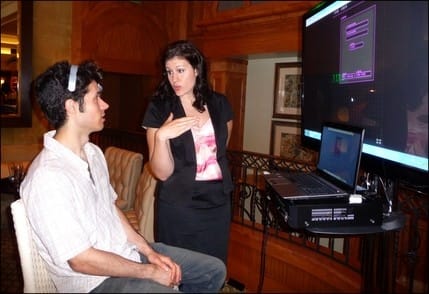
CASA DEL MAR — Old world melded with the futuristic Tuesday night when the Hotel Casa del Mar debuted its partnership with Neurosky, a technology company that specializes in hardware that measures a user’s brainwaves and uses them to manipulate objects and programs.
It was the first of many game nights, called Mind Game Mondays, that the hotel will host in coming weeks, said General Manager James Barela.
“It was a new, innovative thing to do, which is natural here in Santa Monica and at the Casa del Mar,” Barela said.
In the lobby of the opulent 1920s style hotel, well-heeled patrons with drinks in their hands affixed space-age headgear to their brows, resting one sensor on their forehead and clipping a second to their ear lobe.
The delicate equipment measures brainwave patterns and sends signals to computers programmed with games and activities, allowing the user to control the action on the screen by either concentrating or meditating.
As the user looks on, their mental state appears in multi-colored, undulating waves on a diagram depicting various kinds of brainwaves, which scientists have connected to levels of focus or calm.
Gamers use their state of relaxation or attention to cause the image of a ball to levitate, an arrow to hit its target, a bowling ball to strike pins or a barrel to catch fire and explode.
In one real-world game, the headpiece can be used to lift an actual ball and send it flying through hoops or other obstacles.
The conditions under which the machine read users as relaxed or attentive caught some testers off guard, like Valerie Summers, editor of the Southern California Guide.
“I was surprised I did as well as I did,” Summers said, noting that she needs a quiet environment in which to write, but managed to excel at the games despite the crowded, noisy bar.
Jan Frel, an editor with tech website Alternet.org, had a bit more trouble getting his head in line with the results on the screen.
The games and platform are still in their earliest evolution, Frel said, similar to what Pacman is to modern video games.
“It’s primitive, but promising,” he said.
Starting next Monday, the hotel will have four or five of the headsets available at the bar, in what could be considered a spin on the classic pub quiz; bar goers will have the opportunity to square off against themselves in mental combat, and against fellow drinkers in the fall when NeuroSky is expected to debut its two-person games.
The partnership gives NeuroSky a unique opportunity to get the word out on its products, which have been popular in Northern California and the east coast, but haven’t caught on yet in Southern California, said CEO Stanley Yang.
“It’s hard to get people to notice us in Los Angeles, for some reason,” Yang said.
The headsets available at the bar will be there primarily for games, but they could be used in other ways, like measuring how good people are at games as they continue drinking, or how they react to different drinks.
“We’d like to know what kinds of drinks make you do better,” Yang joked.
The company has already used the headset in a promotion for Absolut Vodka. An artist was contracted to use the headset to create a piece of art using their brainwaves to express the taste of the liquor in visual form.
Researchers at USC and UCLA, among others, are also getting in on the action.
Marc Spraragen, a Ph.D. candidate at USC, is working with a team of other developers that are using NeuroSky and other companies’ technology to create emotion-based video games that can be used to register players’ reactions to stimuli in games.
The ultimate goal is to use it in a therapeutic setting, to measure patients’ emotional control, Spraragen said.
“The pie in the sky experiment to have people training as psychiatric workers,” Spraragen said. “When they encounter people in (Veteran’s Administration) who have various emotional problems, can they control their emotions to a particular point where it influences the game?”
Spraragen and his team are working on a gaming world called Cosmopolis, which they hope will eventually be able to hold 100,000 unique players at any given moment in thousands of subgames, all plugged in using one of the companies’ versions of the brainwave headsets.
They’ve only tried it out with 30 users so far, but hope to debut the platform to researchers soon.
“We hope to build up a player base in games that are fun to play, but also designed by researchers for actual experiments,” Spraragen said. “That’s the trick—to make them engaging and also useful.”
People can play with the headsets on Mondays at 6 p.m. at Casa del Mar, beginning Aug. 22.
ashley@www.smdp.com

